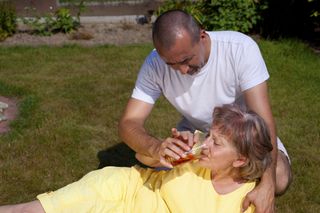Heat Stroke: Causes, Symptoms & Treatment

Heat stoke is a very serious medical condition that happens when the body overheats and is unable to cool down without external help. It causes at least 240 deaths in the United States each year, according to the American Academy of Family Physicians.
Causes & symptoms
Heat stroke, a form of hyperthermia, is characterized by a core body temperature of 104 degrees Fahrenheit (40 degrees Celsius) or greater. "When suffering from heat stroke, the body's natural temperature regulation process is overwhelmed by the external heat," said Dr. Erik Polan, an internal medicine doctor at Philadelphia College of Osteopathic Medicine. "Organ systems may become damaged due to dehydration and elevated internal temperature, which can be lethal."
There are two types of heat stroke. One is generally seen in older patients during heat waves. This is known as classical heat stroke (CHS). The other is seen in younger people who are exerting themselves in a hot, humid environment. This type is known as exertional heat stroke (EHS), explained Dr. Neha Raukar, an associate professor of emergency medicine at Brown University.
While EHS comes on quickly, CHS can take two to three days of exposure to heat to develop, according to the Merck Manual.
According to the U.S. National Library of Medicine, heat cramps — usually muscle cramps in the leg or abdomen — are the first sign of heat stroke. Other symptoms include fainting, dizziness, confusion, lightheadedness, fatigue, headache, nausea, vomiting, loss of consciousness and unusual behavior such as aggression. The person may also have hot, dry or red skin, an increased heart rate and/or a change in their breathing.
Treatment
A person with possible heat stroke must be treated immediately. The extreme heat can damage the heart, brain, kidneys and muscles very quickly. The longer it is left untreated, the worse the damage can become.
"As a neurosurgeon, I feel passionate about raising awareness of EHS, as this condition can cause long-term damage to the brain," said Dr. Julian Bailes Jr., director of the department of neurosurgery and co-director of the NorthShore University HealthSystem Neurological Institute. "I've found that too often, people ignore the warning signs of overheating and their condition turns into a potentially life-threatening medical emergency – EHS – which can threaten organ function or life itself."
To begin treatment, first call 911, and then move the person to a cooler area, if possible. Remove as much clothing as possible and apply cool, wet cloths to the skin to help lower their body temperature. Applying ice packs to the body is also helpful. If the person is conscious, getting them to drink water is also important.
Once in professional care, medical professionals may immerse the patient in cold water, use evaporation cooling techniques, pack the patient in ice or wrap the body in a cooling blanket. Ice packs may also be applied to the neck, groin, back and armpits to lower the body temperature, according to the Mayo Clinic. Medications to stop any shivering, like muscle relaxants, may also be given to the patient since shivering can raise the body temperature, which is at odds with the goals of the treatment.
After treatment, the patient will be required to stay only in cool areas to prevent a relapse.
Prevention
It's important to take preventive measures to avoid heat stroke. "Those most at risk for heat stroke are children, the elderly who may live alone, those with chronic medical issues, and those who participate in strenuous activity outdoors," said Polan.
Some strenuous activities include mowing the lawn, dancing at concerts and exercising outside. While working or exercising in hot temperatures, wear loose, light clothing to reflect light and help encourage airflow for better sweat evaporation. Also, take regular breaks, stay hydrated and try to schedule outdoor work before 10 a.m. and after 3 p.m. to avoid the hottest part of the day.
Being informed about what medications and substances can contribute to heat stroke is also useful. According to the American Academy of Family Physicians, these include:
- Alcohol
- Amphetamines
- Anticholinergics
- Antihistamines
- Benzodiazepines
- Beta blockers
- Calcium channel blockers
- Cocaine
- Diuretics
- Laxatives
- Neuroleptics
- Phenothiazines
- Thyroid agonists
- Tricyclic antidepressants
Don't forget about helping others. Check in on loved ones and neighbors who are in these high-risk groups, and be particularly mindful of small children — never, ever leave a child unattended in a hot car, even for a moment, advised Polan.
From 1990 to 2016, 793 children died of heat stroke after being left in a hot car. The temperature in a car can rise 20 F (11 C) in 10 minutes when parked in the sun, according to the Mayo Clinic. Even in the shade with the windows cracked, the temperatures in a car on a warm day can become deadly in minutes.
Additional resources
Sign up for the Live Science daily newsletter now
Get the world’s most fascinating discoveries delivered straight to your inbox.

